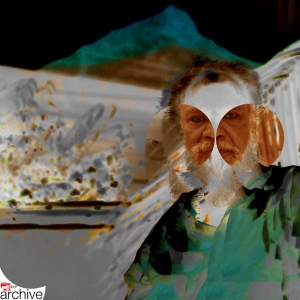In the year 2009, A.P. Santhanaraj passed away and as a tribute to this legend I made the second image titled ‘Eye of an artist’.
Born on March 13th 1932 in Tiruvannamalai, Tamilnadu, Andrew Peter Santhanaraj at the age of four was considered a child prodigy for his fondness for drawing. His powerful and influential mother often distracted him with illustrated alphabets indirectly kindling his interest to the world of visual perception. The young boy was already a rebel in his own right; he considered formal learning artificial and didn’t want to join the local Danish Mission School preferring to pursue a life studying and exploring art. He had heard of the prestigious Madras College of Arts & Craft (then school), and at the age of 10 wanted to join it, but was promptly refused for being drastically underage. He had to wait another 6yrs (1948) for his dream to come true.He completed his Bachelor of Art degree in 1953 with distinction and the gold medal. He then went on to do his Post Graduation (1953 – 55) with scholarship from the same institution. Here, two doyens of the era, Devi Prasad Roy Chowdhury and K.C.S. Panickar shaped his artistic persona. Both believed in non-interference and freedom to the students in their exploration with techniques, materials and basic visual elements. An approach that was congenial to the budding artist, who firmly believed that originality of vision and newness of ideas, should be the very key to learning. Those formative years at the college shaped his vision as an artist. It was here under Panicker’s sway that he developed – the idea of an ‘Indian identity’ within the parameter of world art.
In 1958 at the behest of Panicker who then was the Principal of the Madras College of Arts & Craft, he was appointed as a Lecturer at his alma mater, in the painting dept. In 1985 he became the Principal and continued till 1990. As an art master, he was considered an exemplary mentor, a genius, a pioneer and a trendsetter. In that role he shaped the futures of many promising artists of Chennai like K M Adimoolam, R B Bhaskaran, C Douglas, R M Palaniappan, K. Muralidharan and others. His eccentric nature and emotional passion left a deep impression on them. AP Santhanaraj played a dominant role in the growth and development of the ‘Madras Art Movement’. He is considered by many in South India to be the most influential artist after K.C.S. Panicker and S. Dhanapal that came out of the Madras College of Arts and Craft.
Central to his work from the start was his love for the line; its’ meandering through pictorial space. At some point in his interaction with Panicker he had said “a line is a line, it is universal”. But later in his career when Panickers’ Indian ethos had taken root within him, he qualified this statement to say …”There was something Indian even in a line”. This ethnic sensibility manifested in the primordial quality of his line drawings, giving birth to what could be termed ‘the indigenous line’. Colour was secondary to the line; its use was mostly bright and outlandish. One of the most defining aspects of AP Santhanaraj’s works is the quality of his line. It is this fundamental element, which sets apart this artists stylistic norm. He uses this element spontaneously exploring it endlessly and creating unique visual compositions with it.
A.P Santhanaraj’s contribution to Indian modern art was immense. As an artist he was dedicated to his artistic research, passionate in exploring different mediums and materials. As a teacher he was enthusiastic about his students’ progress and relentless in his effort to make a difference with his pioneering vision. He is considered as one of the pioneers and forerunners of the modern art movement in the country.
(C) All rights reserved. All the images published in this blog is copyrighted property of contemporary Indian photographer Abul Kalam Azad. Text transcribed by Tulsi Swarna Lakshmi. Reprinting / publishing rights reserved by the author and prior permission is required for reproduction / re-publishing, For more information call {0}4175 237405 / {0}94879 56405 or mail to ekalokam@gmail.com / FACEBOOK – Abul Kalam Azad

